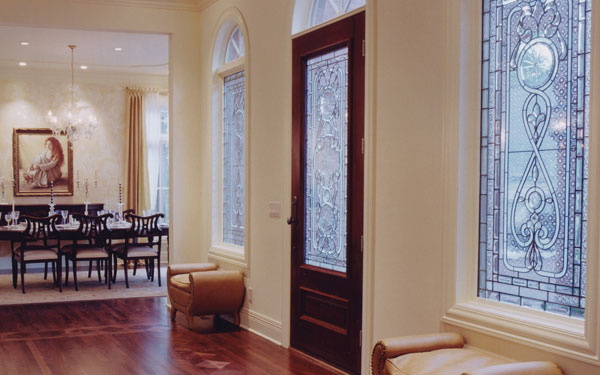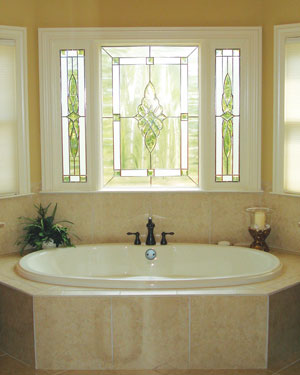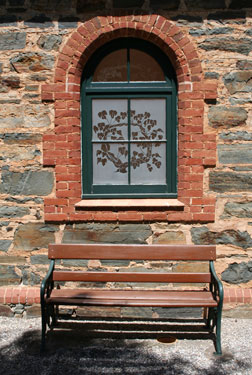 by Jennifer Jones
by Jennifer Jones

View This House Plan
View Other Italian House Plans
Every homeowner knows how beautiful windows can dramatically increase the elegance and style of a room. Glass is a versatile material that is used for a variety of purposes, from windows and cabinets to vases and glasses. It captures the light and grants people remarkable views through it. Stained glass, leadlight windows and window films have become more commonly utilized in many homes today. It can be altered to fit any size and shape opening and provides an illuminating finesse to the décor of the space. Doors, entryways, transoms, ceiling lights, cabinets and other flat surfaces of glass offer the opportunity to create the timeless allure of decorative glass. Bathroom windows, entry doors and front windows are the most popular places to display embellished glass panels. They can add a bit more privacy without blocking natural light from entering the space.
Originally most popular in England during the Victorian era (1837-1901), stained glass windows were typically designed to showcase birds and flowers in small panels. They were often encompassed with cathedral glass that was machine-made, pale-colored and textured. By the early 20th century, many small homes enjoyed stunning leadlight windows. The term “leadlight” is used to describe decorative windows with sections of glass that are supported by lead cames. Stained glass is a type of leadlight window, but it is most associated with the ornate windows of churches and grand architecture. Leadlight windows are more commonly coupled with domestic homes and developed on a more simple scale. By the late 20th century, the two terms
became pretty much interchangeable, whereas the term “stained glass” is now more applicable with any work of art, window or sculpture that uses colored glass.
In today’s time, there are many different variations of leadlight glass. Ones that have the decorated glass sandwiched in between two solid panes of glass are highly efficient thanks to the two insulating air gaps inside the three panels of glass. Window manufacturers provide several options of decorative glass, including leaded, stained, beveled, carved, hammered, jeweled, etched, privacy and many more selections. They are also available in a wide array of styles and shapes from arches, ovals and diamonds to Medieval and Gothic styles.

View This House Plan
View Other Traditional House Plans
Whether you are going to create your own stained glass, purchase one or use window films to decorate glass, it is important to first measure the size of the window. For stained glass, you will need to determine if it will be placed over existing glass or completely replace the glass pane. Most homeowners in the United States will install the leadlight glass over the existing panel on the inside of the home. The type of window frame that the decorative glass will be installed needs to be taken into consideration as well. Some frames are very difficult to completely replace the glass pane. Other frames, like wooden ones, make it fairly easy to replace the existing glass panel with a stained glass one.
There are endless possibilities when it comes to designing decorative glass. Interior design magazines, searching the web and your own imagination are can provide excellent ideas for designs. Once you have an idea in mind, draw or create a template of the design. This template will be incredibly useful when gathering supplies and creating your decorative glass.
Traditionally, lead came and glass pieces were the first materials used to create stained glass windows. Many people agree that the lead produces an appearance of fine craftsmanship and high quality. Another method developed in the 19th century replaced the lead connections with copper foil. Lead came was limiting to flat surfaces, whereas copper foil enables the creation of three-dimensional art. However, the lead is more forgiving to slight errors like chips in the edges of glass, since the edges are embedded in the soldering of the lead. The copper foil is also soldered, but first is wrapped around the edges of the glass.

For those who are not incredibly artistically talented, there are plenty of other methods of decorating glass that produce the Victorian stained glass feeling. Some people will purchase kits that include decorative glass panels that easily snap over an existing window. Other products that can be used to create a decorative window are embossed films, self-adhesive lead strips and glass bevel kits. Decorative and embossed window films are created from a heavy-duty vinyl material. Many films reduce UV rays and come in several different types, from a clear color to semi-translucent to completely opaque. It is also relatively inexpensive compared to actual stained and leadlighted glass. Additionally, decorative films can be easily customized and can add immense style and more privacy to any window or glass surface in your home. There are many websites that can help create a custom design and even upload a photo to use as the template.
After gathering the appropriate products, attach your template design to the front of your glass with clear tape. Apply the self-adhesive lead pieces to the other side of the thoroughly cleaned glass, according to the outlines of your design. Remove the template and clean that side of the glass. While it is drying, cut out and prepare the embossed film pieces to fit the shaped of the design. Some films stick to the glass with static cling and other use adhesives. The static cling films are very versatile, allowing easy removal and do not leave behind a sticky residue. Lightly spray the film, whether it is static cling or adhesive, and use a soft cloth to remove air bubbles and excess water from the film. Take care to trim the film to the middle of the lead lines. It is better to have overlap than gaps between the pieces. If you are adding bevels, apply the adhesive according to the instructions of the bevel kit, let dry for 12 hours and then apply lead lines to the same side on the glass. It is a good idea to test out the materials on a scrap piece of glass, especially if you have never used them before.
Whether you choose gorgeous leadlighted, stained glass or create your own with window films, decorating that plain and boring window will definitely add style and charm to the room. You can express your creative freedom, provide added privacy and produce an upscale look to that sidelight panel, door, window and any other flat glass panel that you wish. No more unsightly views with your new decorative glass.
Here are some related articles:
Save this article to:
back to top